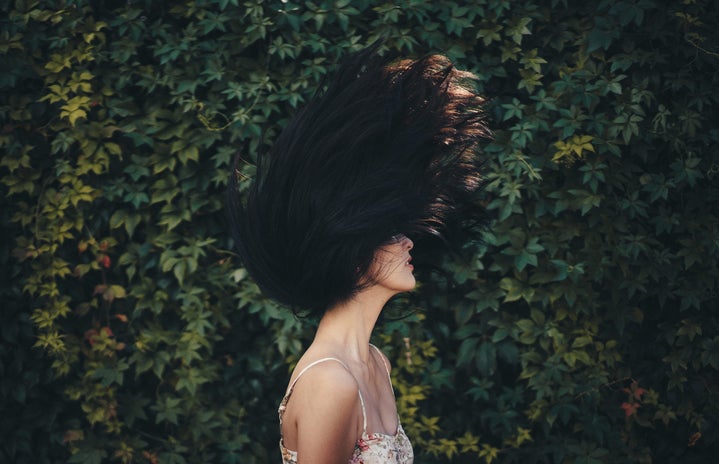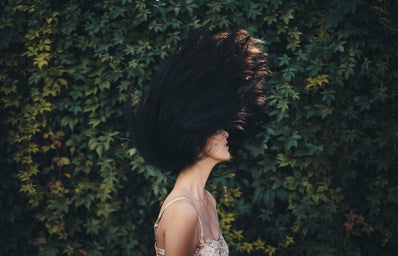Every year on Halloween, my elementary school hosted their annual costume parade and carnival. I was in the girly, princess phase of my life, where pink was every girl’s favorite color and a trip to the mall would not be complete without a visit to Claire’s. Disney princesses were our role models. I was in the third grade, so this was my third time participating in the parade. My sister and I were both going as princesses. She was Aurora from Sleeping Beauty, while I was Cinderella. While my grandmother tended to my sparkly tulle dress, my mother began to braid my hair in order to mimic a beautiful up-do inspired by Lucille Ball. I waited as she began to separate sections of my hair, combing each part gently with her soft and delicate fingers. She gently tugged a portion from the left side of my head, but then she let out a slight gasp.
“What is that?” I heard her whisper to my grandmother.
My grandmother was too shocked to say anything. When I asked what was wrong, they both told me to not worry. I realized that my mother left my hair as it was, undoing the braids she already composed and then placed the tiara on my head. I had known my mother for too long to know that something wasn’t right. Her facial expression said it all.
Image via Business Insider
A week later, she took me to the doctor’s office. In all honesty, I still did not know at the time what was happening. Soon enough, my pediatrician started to gently run her fingers through my hair. When she found her way to the back, I watched in horror as a huge chunk of hair fell off from my head. My doctor handed me a mirror and there it was–a two-inch bald spot on the back of my head. I will never forget my thoughts and feelings at that moment. My mother was trying to keep herself calm, but I could tell she was thinking the worst. A specialist came in 20 minutes later to diagnose my condition as alopecia areata.
Alopecia areata is an autoimmune disorder in which the body attacks its own hair follicles, causing the hair to become brittle and eventually fall off from the scalp. At times, the hair loss can spread to the rest of the body. Unfortunately, there were no treatments available for my condition. However, the specialist suggested that I see a dermatologist every three weeks to inject cortisone into the bald spots to reduce inflammation. Now, I would wince when a nurse gave me a flu shot. How was I supposed to keep calm for 40-50 shots on my head?
Image via Renew Physical Therapy
Having alopecia in elementary school felt like torture. My bedazzled headbands and baby pink scrunchies were replaced with patterned bandanas and unflattering hats. Other students took notice of my sudden hairstyle choices and spread rumors of what was hiding underneath my bandana. One time, the same old troublemakers cornered me in the playground. One of them distracted me by taking my lunchbox, and his accomplice came up behind me out of nowhere and pulled off my bandana. Tears began to spew out of my eyes as they began pointing and laughing. The boy who took my bandana threw it back at me with a disgusted look on his face. The leader of the group then said, “Don’t touch her, otherwise you’ll catch it too!” That was my life for the last two years of elementary. Constant bullying. Constant fear. Constant tears.
Image Courtesy of Leonardo Birog
At first, the cortisone injections worked. My hair started growing back, despite there being only one or two small little bald spots towards the back of my head. My family was also incredibly supportive. My mother woke me up earlier than usual to help style my hair in ways that hid the spots. My father rubbed the spots with hot oil and herbs, which according to him, was a home remedy that helped treat hair loss patients in the Philippines. My grandmother lit a candle in my honor during mass, praying that my hair would grow back. Even my little sister helped out by constantly giving me encouraging messages and words of support, which is precisely what I needed. However, while entering high school, the treatment stopped working and chunks of hair began to fall off again. My dermatologist approached me with other treatment options, including rubbing the oil from poison ivy onto the scalp, which gave me horrible side effects. The oil had spread to my face and left me with red welts on my cheeks and arms.
Image Courtesy of Leonardo Birog
The physical pain from the shots was excruciating, but was not what hurt the most. My hair loss caused deep emotional pain. It epitomized the loss of my femininity. Before it, I had long, thick hair that draped down my back like a waterfall. I could style it however I wanted. I could put it into pigtails, braid it, and put it into a bun just like Cinderella. I could no longer do this anymore. With my hair loss, I also lost my dignity, my confidence, and hope. The media also imposed unrealistic beauty standards. Having long, flowing hair is a defining characteristic of woman. And I didn’t have that.
Image Courtesy of Gabrielle Birog
Once I came to UCSB, I decided enough was enough. I was sick of the unpredictability, the injections, and the time spent styling to hide my insecurities. In winter quarter of my freshmen year, I decided to shave my head and start wearing wigs. I cried the whole time as I watched my hair fall into the sink. As my mother cut each strand, I could feel my heart sinking deeper. After wiping off the tears from my cheeks, I let out a sigh of relief. All this time, I felt my condition was controlling me; telling me how to run my life, reminding me of my unattractiveness and preventing me from becoming a princess. But looking at myself in the mirror with the scissors in my hand assured me that I was now in control.
My family and friends could not have been more supportive of my decision. When I showed my boyfriend my new “hairdo”, I thought he would run away in terror. But instead, he kissed my bald head and told me I never looked more beautiful. A couple days later, he surprised me with a beautiful wig that resembled my hair before I lost it all to alopecia.
Image Courtesy of Gabrielle Birog
Losing my hair was indeed a journey of ups and downs. There were the good times, like when I noticed the hair starting to grow back. And then there were the bad. During my middle school and early high school years, it had taken a toll on my mental health. In the moment, shaving my head was the hardest thing I had to do, but it was also the best thing. I finally broke free from the chains of those unrealistic beauty standards and learned to love myself for who I am. I am now at ease with my condition. Instead of focusing on my appearance, I prioritize my academics, family, and character. While it took me a while, I learned that having no hair does not make me any less of a woman. Beauty comes not from the head, but the heart.
Image Courtesy of Gabrielle Birog



